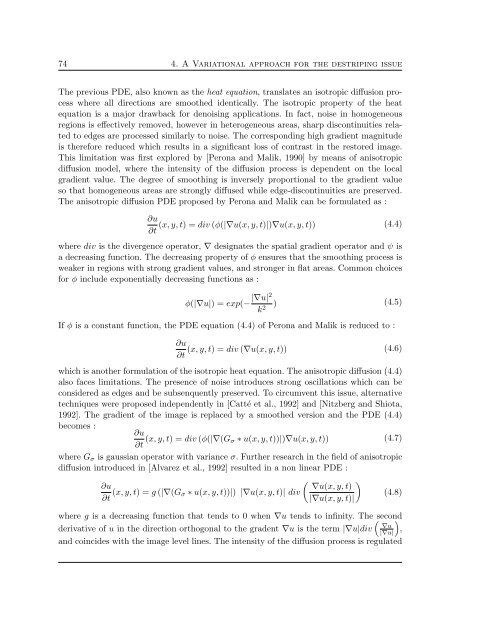Th`ese Marouan BOUALI - Sites personnels de TELECOM ParisTech
Th`ese Marouan BOUALI - Sites personnels de TELECOM ParisTech
Th`ese Marouan BOUALI - Sites personnels de TELECOM ParisTech
Create successful ePaper yourself
Turn your PDF publications into a flip-book with our unique Google optimized e-Paper software.
74 4. A Variational approach for the <strong>de</strong>striping issue<br />
The previous PDE, also known as the heat equation, translates an isotropic diffusion process<br />
where all directions are smoothed i<strong>de</strong>ntically. The isotropic property of the heat<br />
equation is a major drawback for <strong>de</strong>noising applications. In fact, noise in homogeneous<br />
regions is effectively removed, however in heterogeneous areas, sharp discontinuities related<br />
to edges are processed similarly to noise. The corresponding high gradient magnitu<strong>de</strong><br />
is therefore reduced which results in a significant loss of contrast in the restored image.<br />
This limitation was first explored by [Perona and Malik, 1990] by means of anisotropic<br />
diffusion mo<strong>de</strong>l, where the intensity of the diffusion process is <strong>de</strong>pen<strong>de</strong>nt on the local<br />
gradient value. The <strong>de</strong>gree of smoothing is inversely proportional to the gradient value<br />
so that homogeneous areas are strongly diffused while edge-discontinuities are preserved.<br />
The anisotropic diffusion PDE proposed by Perona and Malik can be formulated as :<br />
∂u<br />
∂t (x, y, t) =div (φ(|∇u(x, y, t)|)∇u(x, y, t)) (4.4)<br />
where div is the divergence operator, ∇ <strong>de</strong>signates the spatial gradient operator and ψ is<br />
a <strong>de</strong>creasing function. The <strong>de</strong>creasing property of φ ensures that the smoothing process is<br />
weaker in regions with strong gradient values, and stronger in flat areas. Common choices<br />
for φ inclu<strong>de</strong> exponentially <strong>de</strong>creasing functions as :<br />
φ(|∇u|) =exp(− |∇u|2<br />
k 2 ) (4.5)<br />
If φ is a constant function, the PDE equation (4.4) of Perona and Malik is reduced to :<br />
∂u<br />
∂t (x, y, t) =div (∇u(x, y, t)) (4.6)<br />
which is another formulation of the isotropic heat equation. The anisotropic diffusion (4.4)<br />
also faces limitations. The presence of noise introduces strong oscillations which can be<br />
consi<strong>de</strong>red as edges and be subsenquently preserved. To circumvent this issue, alternative<br />
techniques were proposed in<strong>de</strong>pen<strong>de</strong>ntly in [Catté et al., 1992] and [Nitzberg and Shiota,<br />
1992]. The gradient of the image is replaced by a smoothed version and the PDE (4.4)<br />
becomes :<br />
∂u<br />
∂t (x, y, t) =div (φ(|∇(G σ ∗ u(x, y, t))|)∇u(x, y, t)) (4.7)<br />
where G σ is gaussian operator with variance σ. Further research in the field of anisotropic<br />
diffusion introduced in [Alvarez et al., 1992] resulted in a non linear PDE :<br />
∂u<br />
∂t (x, y, t) =g (|∇(G σ ∗ u(x, y, t))|) |∇u(x, y, t)| div<br />
( ∇u(x, y, t)<br />
|∇u(x, y, t)|<br />
)<br />
(4.8)<br />
where g is a <strong>de</strong>creasing function that tends to 0 when ∇u tends to infinity. The( second )<br />
<strong>de</strong>rivative of u in the direction orthogonal to the gra<strong>de</strong>nt ∇u is the term |∇u|div ∇u<br />
|∇u|<br />
,<br />
and coinci<strong>de</strong>s with the image level lines. The intensity of the diffusion process is regulated















